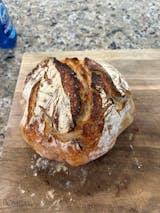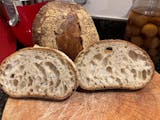Creating a Gluten Free Sourdough Starter
How to create a great gluten free sourdough starter by converting the Kensington Sourdough 150 Year Old San Francisco Sourdough Starter
We often get asked if the starter is gluten free, or if it could be gluten free, or if we have a gluten free sourdough starter for sale.
I thought it would be helpful to create a page that would answer these questions in detail and help these customers! As usual, I am still not a doctor (I keep checking!) so absolutely none of what follows should be considered medical advice!
First we will talk about the Kensington Sourdough Starter and gluten, and the next section will be how to convert the "normal" starter to a gluten free starter. If you are a complete beginner and wondering what a Sourdough Starter is in the first place please take a look at What is a Sourdough Starter and why you should you want One
The 150 Year Old San Francisco Sourdough Starter and Gluten
First, at kensingtonsourdough.ca we only sell one thing! The starter that we sell is maintained on good Canadian all purpose flour, and that flour contains gluten.
So why do many people with gluten sensitivity look to sourdough bread?
Science has some answers!
Sourdough bread uses wild yeast and lactic acid bacteria for fermentation.
During the fermentation of sourdough, enzymes produced by the wild yeast and bacteria work to break down gluten into simpler components. While this process will not render sourdough entirely gluten-free, it does significantly reduce the gluten content compared to conventionally leavened bread.
The degree of gluten breakdown varies based on factors such as fermentation time, temperature, and the composition of the sourdough starter. Longer fermentation periods generally result in more extensive gluten degradation.
But is Sourdough Bread "OK" to eat for people with Gluten Sensitivity?
Maybe. I find that the argument over whether sourdough bread is "OK" for people with gluten sensitivity is usually rooted in some confusion between two distinct groups of people who both consider themselves to be "gluten free".
For many people gluten is something they want to mitigate and generally avoid/have less of. For this group making their own sourdough bread is often fantastic as they tolerate it fine!
For others, gluten is considered more like an allergen, and no amount of gluten is considered to be "OK". For this group regular sourdough loaves made with wheat or rye flours are almost certainly going to be off limits.
This first group might want to experiment (with advice from their healthcare professionals!) with using wheat or rye flours with their sourdough baking.
The second group will likely want to use gluten free flours and a gluten free sourdough starter! So how would we do that? One way is by converting the Kensington Sourdough 150 Year Old Starter to a gluten free starter!
Converting your Starter to a Gluten Free Starter
My advice here for conversion is very similar to my advice for switching the starter to a rye starter or similar. Best practice is to activate it first using the food it is used to (all purpose flour), and then switch it to the new source of food.
Step 1: Make sure your starter is active!
Your starter should be at least a week old before starting the conversion, and should be bubbly and double in size after feeding! If you have any issues getting to this stage please take a look at my Sourdough Starter Tips and Troubleshooting guide!
Step 2: Gradually introduce your starter to the new Gluten Free food!
What flour?
Two popular options are Bob's Red Mill Gluten Free 1-1 Baking Flour and one of the King Arthur Gluten Free flours. Please check the ingredients however to ensure there are no additives you don't want!
My customers have also used buckwheat, brown rice flour, sweet rice, sorghum flour, millet, teff..... and many permutations and combinations of these! As usual experimentation is encouraged!
Whichever flour or flour mix you choose, best results will come if you introduce the new "food" gradually and keep the starter thick!
Introducing the new food gradually
Your starter is a living micro-colony. It can and will adapt to new food, but it will not like doing this all at once! Instead, start by introducing a mix of the flour that it is used to (All Purpose) and 25% of the new food. If this goes well half and half, then three quarter, and then 100% new food! The percentages here do not have to be exact, as long as the process is gradual and spread over a few feedings.
Please be patient here and keep an eye on how your starter is reacting!
Some reduced activity is to be expected, however we still want to see it bubbling and rising after feeding to some extent! If it does not consider the flour mix and/or back off a bit. Use your senses and instincts here.
Keep your starter thick!
Some smarter people than the author of this article have run experiments indicating that keeping a thick starter is important for gluten free sourdough starter success. Keeping it thick is my suggestion for all starters, but it may be especially important here!
Step 3: Keep discarding and feeding until it is Gluten Free (or Gluten Free enough?)
Some of my clever readers at this point might have reasoned that if the starter started out with wheat flour (and gluten), and during "conversion" you are only discarding most (but never all) of the starter before feeding.... then logically would always be some gluten remaining?
We might call this the Zeno's Paradox Theory of Gluten Free sourdough starter conversion.
Before we run to throw it away, however, we should consider that each time you discard and feed you will be removing 60-80% of your starter, which would also remove 60-80% of the trace gluten. After a week of discarding and feeding, the expected amounts of gluten remaining get very small indeed. For example when you reduce 100 grams by 75% ten times, you end up with 1/10th of 1 milligram! For frame of reference there are usually 2-4 grams of gluten in 1 slice of regular store bread.
There are many people with extreme gluten intolerances who may not find the above re-assuring... and I understand completely! Again please consult with a health professional if you are contemplating dietary changes!
Step 4: Bake your delicious Gluten Free Bread!
Once the starter has adapted to the new food it is time to bake! Please be aware your new starter may behave in a more subdued manner than your old All-Purpose fed one.... this does not mean it will not work great for your projects! The reduced visual activity is likely more of a function of the characteristics of the flours used as opposed to an indication that the starter is less viable.
As for recipes... GF baking is a newer frontier than wheat and rye sourdough baking, but as usual the internet has your back, so google, experiment, repeat!
If you need help with what baking tools or items to buy we have a list here in our Sourdough things you might want to buy article.
Feel free to tag any successes to our Instagram @kensingtonsourdough. And don't forget to follow us when you are there!
Note: A few of the above links contain Amazon affiliate links/tags. If you were to click on them and purchase a product, I might make a small commission as a result of that sale. If you ever see me in real life please remind me of this and I will buy you a coffee with my ill gotten riches. Try not to get fingerprints on my Lamborghini however!





